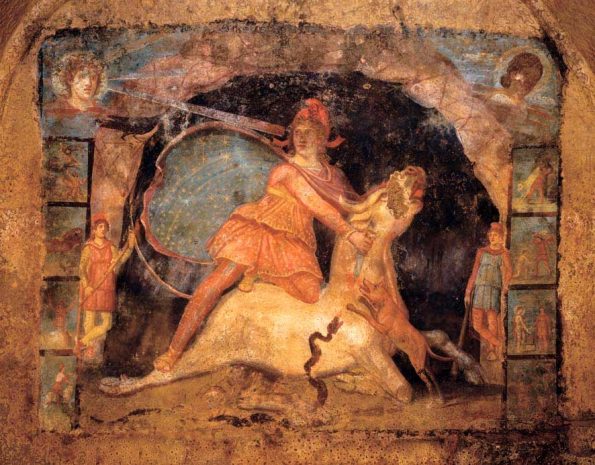Il territorio del Comune di Marino è situato a sud di Roma, sui Colli Albani nell’area dei Castelli Romani, stretto tra Rocca di Papa, Castel Gandolfo e Grottaferrata. In virtù della sua posizione collinare gode di un clima salubre e da sempre è luogo di villeggiatura ma sono proprio le sue caratteristiche ad aver dato vita a tradizioni vitivinicole che hanno reso celebre l’omonimo vino bianco a denominazione di origine controllata e la Sagra dell’Uva, la manifestazione più antica in Italia nel suo genere, nata nel 1924 per volontà del poeta e drammaturgo Ercole Pellini, conosciuto come Leone Ciprelli . Marino fu il set per numerosi film di Federico Fellini ed è comprensibile proprio per la sua tipicità, tanto da sembrare un quadro d’autore, arroccata e affascinante, ricca di storia e di arte, di tradizioni e di folklore mai persi grazie all’impegno della popolazione.
A raccontarci la storia di Marino è Alessandro Bedetti, Direttore del Museo Civico, che spiega «La città di Marino deve il suo nome al Castrimoenium, che fu fortificato da Silla e innalzato a Municipium. Durante il Medio Evo assunse una rilevante posizione strategica che lo portò ad essere controllato da vari feudatari. Dopo i Frangipane, nel 1266 il feudo passò agli Orsini e nel 1419 il borgo pervenne ai Colonna, che ne mantennero il possesso fino al XIX secolo, trasformandolo da borgo fortificato a luogo di riposo e svago della famiglia.
Con l’apertura della Via Appia nuova – continua di Direttore – dovuta a papa Pio VI, Marino perse il suo ruolo divenendo un tranquillo paese della Campagna Romana, elevato a città nel 1835 da Gregorio XVI. Importanti testimonianze del passato sono ancora visibili nel centro storico, tra esse la più importante è un santuario del dio indoeuropeo MITHRA, ricavato all’interno di una cisterna di una villa romana. Sulla parete di fondo fu eseguito un affresco policromo rappresentante il dio nell’atto di tagliare la gola ad un toro bianco contornato da otto scenette.
Nella parte alta del paese dove sorgeva la rocca e si apriva una delle porte della città, sorge l’ex chiesa di S. Lucia attuale sede del Museo civico.
Fondata agli inizi dell’XII secolo su una cisterna romana, deve il suo aspetto attuale goticheggiante ad una serie di arconi a sesto acuto dovuti alla ristrutturazione del XV secolo; la sua facciata ingloba una casa torre risalente al X secolo mentre all’interno si possono vedere ancora una bifora, un rosone ed un affresco rappresentante S. Onofrio databili al XIV secolo. Nel XVII secolo la chiesa fu sconsacrata e il suo ruolo venne assunto dalla Basilica collegiata di S. Barnaba Apostolo fatta erigere dal cardinale Girolamo Colonna; al suo interno si conservano opere del Maratta, dell’Algardi, del Ferrata e del Ghezzi, mentre la pala d’altare raffigurante il martirio del santo è opera di Bartolomeo Gennari discepolo del Guercino. Altro complesso fatto costruire dai Colonna è il Monastero del Santissimo Rosario con la chiesa progettata da Giuseppe Sardi, che presenta un interno ricco di stucchi e un tabernacolo attribuito alla scuola di Mino da Fiesole. Poco distante si trova la chiesa di S. Maria delle Grazie, edificata intorno al XV secolo – conclude Alessandro Bedetti – vi si conservano un affresco di Benozzo Gozzoli e un S. Rocco attribuito al Domenichino.»
Marino "Antica" e sotterranea

La città di Marino poggia su un vasto reticolo di grotte, alcune comunicanti tra loro, che si trovano a circa 12 metri al di sotto della superficie stradale e si sviluppano per decine di chilometri nel sottosuolo del Centro Storico. La loro storia è antica, furono scavate nel tufo vulcanico per ricavare materiale da costruzione già nel periodo medievale. Gli scavi poi proseguirono anche in epoca romana. La recente ristrutturazione consente oggi di fruire appieno di questo patrimonio sotterraneo che testimonia la peculiarità storica e antropologica della città. Nel comune di Marino, località Santa Maria delle Mole, è visibile un pezzo dell’Appia antica.
Il Carretto a Vino

Prima degli anni ’50 con l’arrivo dei mezzi più moderni di trasporto, per portare il vino nei mercati dove vendere il “nettare degli Dei”, si usavano dei carretti molto particolari, chiamati Carretti a vino. A secondo del luogo di provenienza, il carretto era decorato secondo i gusti e le usanze del comune di appartenenza. Il carrettiere (colui che guida il carretto, trainato da un cavallo) su questo mezzo caricava sul pianale 8 barili da 60 litri, più uno da 5 litri, accanto al sedile dell’uomo. Al “Museo del Carretto a Vino” di Marino, gestito dalla locale Pro Loco, è possibile ammirarne uno in perfetto stato, risalente ai primi del ‘900.
Odori e sapori unici: la Ciambella al Mosto

Ci hanno provato in tanti ad imitarla ed effettivamente in parecchi comuni dei Castelli Romani si sfornano delle ciambelle, ma quella di Marino è unica, riconosciuta come patrimonio della locale comunità e irripetibile. Il profumo è inebriante. La storia della Ciambella al Mosto di Marino risale al XIV secolo, quando il castello della città venne assediato da Cola di Rienzo. I cittadini di Marino, per far desistere il tribuno dall’impresa, inviarono un mulo con due bigonce colme di ciambelle. Non chiedete qual è la ricetta, perché nessuno è disposto a rivelarla: se volete mangiarla, recatevi a Marino e, appena dopo la vendemmia, potrete gustarne l’estrema bontà.





